|
QRP Notes |
|
QRP Notes |
I have been a keen QRP operator for a long time. I can remember way before I
was licensed reading an article in an old CQ magazine about a ham with a small
homebrew QRP rig camping in some secluded spot and working amazing DX at night
with his wire antenna over a tree. I think that story was one of my biggest
inspirations to obtain my license! It seemed like such an adventure being out in
the wild and working the world on low power by the firelight.
Now fast forward many years.....
In 1996, shortly after I obtained my ZR (restricted, non HF) license I
started learning CW with the sole purpose of upgrading my license so that I
could operate QRP on the HF bands. After a few initial false starts, I was
having a problem learning CW, I discovered that my problem was with slow CW,
starting at 5wpm simply did not work for me, I was trying to listen to the dots
and dashes and trying to remember what each meant. It did not work well. What I
did discover that at higher speed, at least 25wpm and more, I was hearing the
"music" and the words. Soon I could copy well at higher speed and the upgrade to
a ZS (unrestricted) license was done. My first call sign was ZS6VER. Then the
fun really started!
Initially I was using normal radios turned down to 5W
or below for QRP work. It worked well but was not ideal for portable or hiking
use. I did build a few transmitters and receivers but I was never really
satisfied with their performance. As soon as the Icom IC-706 was launched I
acquired one, This was more like it, small enough to carry but with decent
performance on the crowded bands. There was only one disadvantage, even at low
power it was heavy on the battery, and large batteries are heavy. I normally
used 7Ah gel cell batteries to power the IC-706, they were not that light but do
provide a reasonable amount of operating time.
In spite of these large
current requirements I still had lots of fun with the radio in the bush, on
mountain tops activating SOTA peaks and even on a yacht.
And then the
Yaesu FT-817 was announced, now this was more like it! I just love my FT-817, I
have been using it for years and it still amazes me with it's great performance
and lots of features in such a small and light package. I am now looking for a
later FT-818D model but that is mostly because I am weak at resisting new
toys.... (Update 2021, the FT-818D never happened, the R928+ SDR took it's
place)
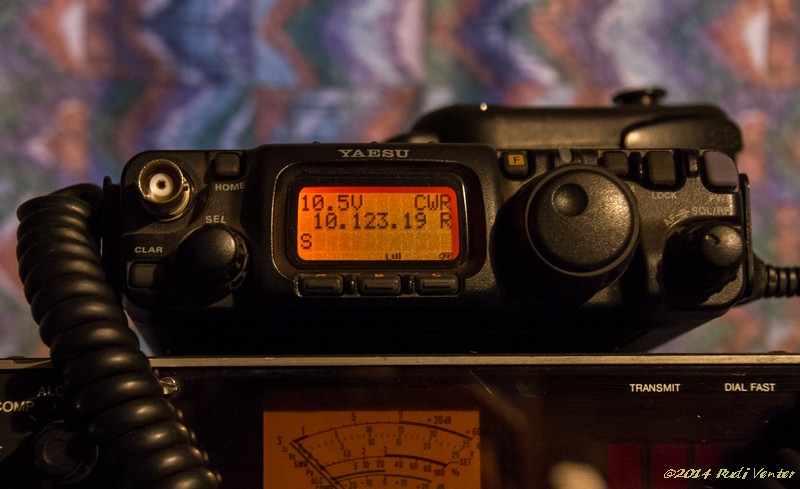
I have been using the internal battery on the FT-817 and also
the same 7Ah gel cell as used on the 706. Over the last year or so I have been
involved with multi rotor drones used for aerial photography. As a side effect
of building and flying these drones I acquired a large collection of Lipo
batteries, ideal to power the 817 so now I have a power supply that is a lot
lighter, less than 30% of the weight of the gel cell for the same capacity, and
more compact!
For QRP field work I have been using my multi band dipoles,
normally legs for 40m, 20m and 10m on the same feed line. This works well for
10, 15, 30 and 40m. I have also recently added a LDG 100 II tuner to help with
matching the antenna. This is a light auto tuner that needs very low power, it
will run for a year or more with an internal set of AA batteries.
I am
now also looking at an end-fed dipole for 6-40m, hope to try it soon. If it
works well I will publish the details here.
Update
19/7/2025:
It is the winter leg of the SARL QRP
contest today. I have not really competed in any SARL contest the last few
years so I decided it was time to join in the QRP fun again!
I decided
to combine it with a POTA activation. Since I did not have time for a lot of
traveling I decided to activate my local POTA site, Suikerkop Hiking trail
(ZA-0078) again.
After I planned everything I decided to just read the
SARL rules for the QRP contest to make sure I do not make a fool of myself.
Sadly I discovered that the rules specifically forbid combining the contest
with any POTA/SOTA activity! Sorry, but I think that is just plain stupid! Now
I remember why I do no compete in SARL contests, so many silly illogical and
annoying rules....
Anyway, I decided to still go and have fun in the
contest, I decided I would simply not send in the log to the SARL (as a silent
protest!) and just make it a POTA activation.
I ended up having fun.
Sadly no DX contacts, it was too early in the day (7:00 to 9:00 UTC) but I did
manage to make quite a few local contacts on SSB and CW. Some of the contacts
were made running only 1W!
Equipment consisted of my well loved Xiegu
X6100 and an EFHW antenna held up with a 12m telescopic mast. Since there are
no trees taller than 2m on the hiking trail I had to use a mast!
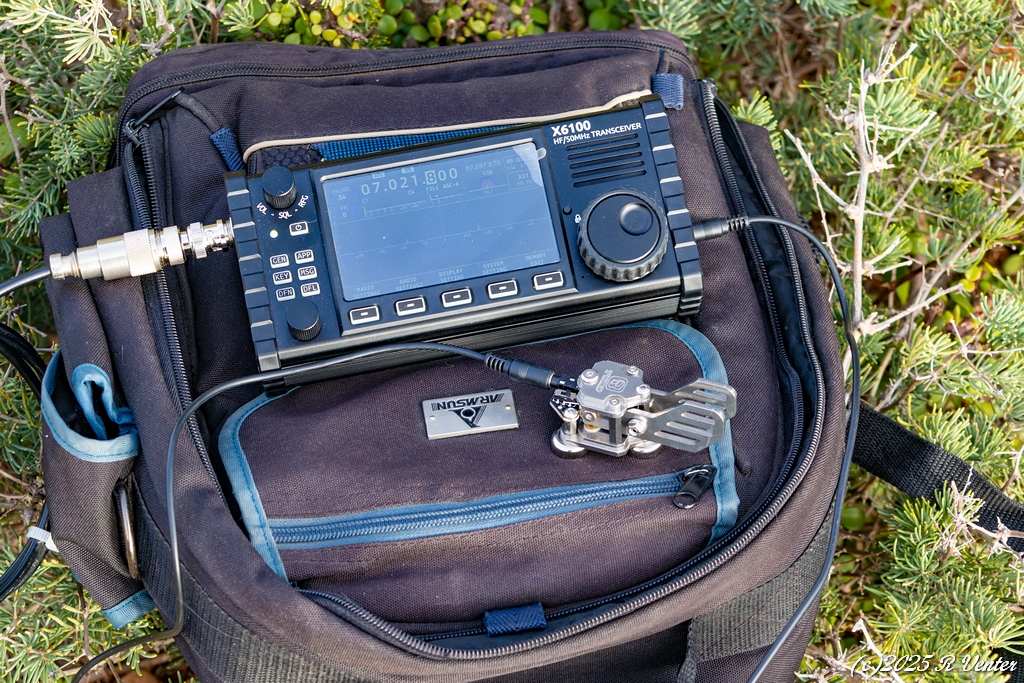
Minimalistic
station.

Station and antenna, yes, that pole is VERY flexible!
I ended up running the whole 2 hours plus on the internal battery of the X6100, low power does have it's advantages. I am looking forward to spring and some warmer weather for more activations! It was only 2.5C when I started!
Update 23/3/2024:
I had
fun activating POTA entity ZA-0078 (Suikerkop Hiking trail) yesterday
afternoon. It was not an easy activation. Band conditions were down during the
time I was activating, I could hear stations on 10 and 15m but they were way
down. Eventually I did manage to make a few DX contacts but 2 weeks earlier
same time of the day I worked over 100 DX stations from my field station.
There were also weather issues, it rained twice, hard enough and with
lightning in the area that I took the antenna down twice and had to find a
place to hide. After the second time I went back to my vehicle, fortunately it
was parked at the start of the trail, within the 30m specified in the rules so
I just completed the activation from inside the car while it was raining
outside.
The Yaesu FT-891 worked perfectly, it will now become my field
radio of choice unless I am planning a long hike.
The EFHW also worked
well. I used the new Spiderbeam 12m fiberglass mast. It worked ok but it is
far more flexible than I thought it would be. Even in a modest wind it bent so
much that the antenna was no higher than it would have been on my far stiffer,
and lighter, Comet 8m mast.
I need to decide on the mast, maybe if I
use a dipole that is fixed at 2 ends it would be better but with the EFHW with
only one side tied down it bends far more than what I would like even with
modest tension on the antenna, the antenna was still sagging quite a bit so I
could not put less tension on the antenna.

Look how far
the mast bends with the EFHW, and the antenna is not even under much tension!
I am already planning the next activation, it will most likely be ZA-0075,
Baviaans Kloof, as I was there during the SARL field day and it was a great
location. Back then it was not a registered park but it is now. I will use the
same setup but might go back to the Comet mast.
A more complete report
on the ZA-0078 Suikerkop Hiking Trail activation can be found
HERE.
Update 11/3/2024:
The day after Field day!
It was fun! The
weather was great, not too hot with a light breeze to keep things cool. The
5km hike was fun, everything I needed for camping was in my normal backpack
and I also carried a small "pouch" with my radio equipment. I ended up taking
the Xiegu X6100 but I left the Micro PA50 amplifier behind, mostly due to the
fact that I did not feel like carrying the extra batteries it would need, it
turned put to be a good decision as I never felt I needed more than 5W, the
X6100 can do up to 10W with an external battery so I did have some power (1/2
S point) in reserve.
Logging was done on an iPad. I actually wanted to
do paper logging but forgot the paper and pen at home! Fortunately I had the
iPad with me, I use it for navigation and to have something to read when I am
in the tent at night.
The antenna I took was the (now well loved) 40m
EFHW kept aloft with my 8m Comet mast. This is one thing I need to change,
this mast is fantastic but simply too heavy and clumsy to carry. Time for a
nice compact carbon fiber mast!
I found a nice spot to camp and put up
my station below a wild prune tree/bush. It is supposed to be a tree but they
never grow high in this area, there was just enough height to sit below it. It
gave me great protection from the sun.
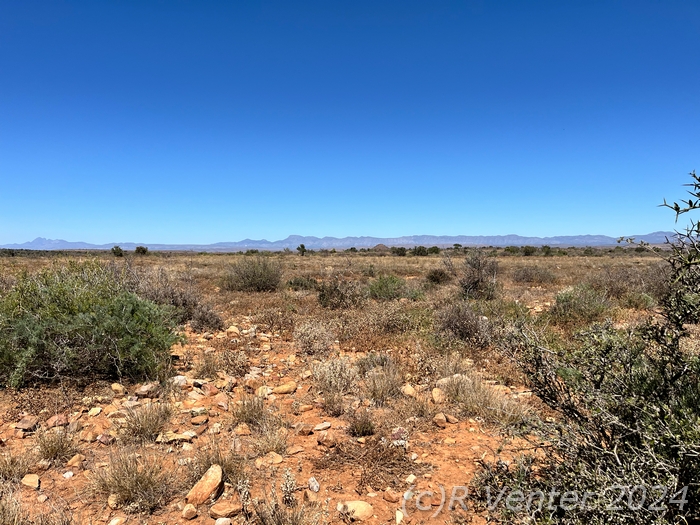
The view from my operation position. Yes, it is a
very dry area!
I soon had the antenna up and the station on the
air. My first contacts were with local Field day stations on 40m SSB. The
setup was working well so soon I had everyone logged I could hear. I then had
a nice long chat to a few friends, was fantastic to hear all the stations so
strong, my noise level on 40m was below S1!
Late afternoon I moved to
10m CW and soon the DX was rolling in, there was a South American contest
running, I seemed to have great propagation into South America so by the time
my batteries were almost flat (I did not expect so many contacts so I miss
calculated and did not bring enough batteries, lesson learned!) I had more
than 100 DX qso's as well as a few nice DX chats in the log. Great fun!
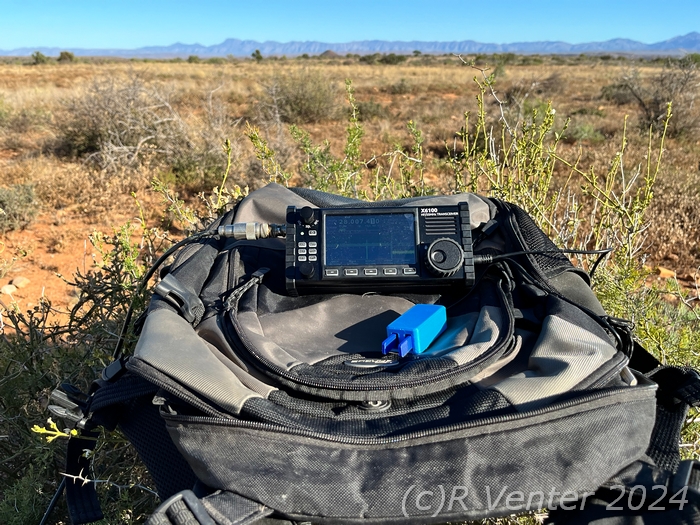
My very basic station in action!
After a good night's sleep, complete with Owls and
Jackals visiting, I managed to make a few more CW DX contacts on 40m before
the radio complained about the batteries.
As it turned out I had the
radio's "cut off" voltage level set a bit high, checking the batteries at home
showed that they were still at around 60% charge level, another lesson
learned.
It was great fun, the scenery, peace and quiet and the
extremely low levels of noise on the bands made it special. I will be taking
my radio hiking again soon!
Update 7/6/2023:
I recently took the little R928+,
along with my EFRW antenna to my yacht. I lifted the end of the antenna up the
mast, about 20m and connected the ground to the railing on the yacht. Running
about 6m of RG58 (all I had) the setup worked surprisingly well. I did use my
little HF-100 auto tuner to lower the SWR on some bands.
The
combination worked well, I just need to setup a decent power line from the
yacht's 12V battery bank. I just had it conected to a 12V outlet normally used
to charge phones and iPads from and at anything above 2.5W the voltage was
dropping right down causing distortion on SSB, an easy fix I will do next
time.
Update 16/4/2021:
This morning at about 7am we had a power outage.
Since I had just completed my EFLW antenna I decided it was the perfect
opportunity to take it out into the garden and test it. I connected 17.5m of
wire to the output of the unun and made 8 x 4m radials. The feed side of the
antenna was attached to a low branch of a nice shady tree and the other side I
ran out to another tree and attached it about 3m above the ground. I wanted it
low incase I needed to trim the wire a bit.
The MFJ antenna analizer
showed that the antenna had SWR dips at 40m, 20m and very low SWR at 15m but
all the dips were just below the bands. I trimmed the wire a bit and tried
again. Eventually I removed about 0.5m of the wire, the dips were now inside
the bands but other than 15m the SWR was too high to use just like that. I
connected a MFJ manual tuner and tuned the antenna, now it was easy to match
on all bands.
I experimented a bit with the radials, by far the
best result was with the radials attached to the ground lug of the tuner and
not to the unun. I then connected my trusty Yaesu FT-817 and listened around a
bit. Since it was still early in the morning only 40m showed signs of life.
The FT-817 was running from internal batteries so max power out was no more
than 2.5W but soon I had made a few QSO's on CW and SSB with good reports. The
antenna seems quiet and works better than what I expected after I saw the
rather high SWR on most bands. I briefly took the FT-817 inside and connected
it to my 40m dipole, the WFLW seemed to give better results, on RX anyway!
Maybe I need to check the feed line (rather old) to the dipole, it is MUCH
higher than the EFLW so it should produce better results.
Anyway, went outside again
and made another QSO. I was just finished when I heard my name being called,
not on the radio but from my gate! I was rally glad to see our local courier
lady, she had my R928 Plus!
I had it unpacked and
running in no time! What a nice little radio! I did disassemble it to check
all the solder work. I am glad I did, I found the screws holding the PCB's
together were loose to the point of falling out, the PCB's would not have
moved but the metal screws could well have caused a short! I also found that
the USB-C port had dry solder joints on the shell, this allowed a small amount
of movement in the connector that would surely lead to broken connections. I
re-soldered this carefully, everything now seems nice and solid!
Once I had it reassembled
I ran into a problem. A normal CW key worked fine but when I tried to key the
radio from a computer, using a standard interface I have used for 25 years on
lots of different radios, I found that as soon as I plugged the interface into
the computer the radio would key and not unkey until I unplugged again. I
checked all the cables and connectors but no-go. Seems like there is tiny bit
of current flowing even when the "contacts" in the keyer (transistor switch)
is suppose to be open. It has never bothered and other radio. This is rather
frustrating as for contesting I use the N1MM+ logger and the keyer that goes
with it.
After testing a few other keyers I decided that
this is not going to work without some mods to the radio or the keyer....
But there is another
option! You can also key the radio via the USB port, I tried this and
everything was up and running.
By now our power was back
and I was in the shack playing with the radio and making a few contacts. First
impressions are that the RX is really great and it seems nice and selective
and not bothered with close-by strong signals. On CW the filters are really
nice with steep skirts, far better than most of the other radios in my shack.
I still want to upgrade
the firmware to the latest, it has really old firmware and then I want to
setup everything from the bias to the EQ and power output on all bands.
Talking about bands, this radio has the Si5251a synthesizer so it will go to
6m, I tested it there and it does TX, it might also work on 4m and 2m, it does
RX there but I need to check TX, first I want to make sure the bias on the
finals and output limits are fine as oscillation could be a problem on the
higher bands.
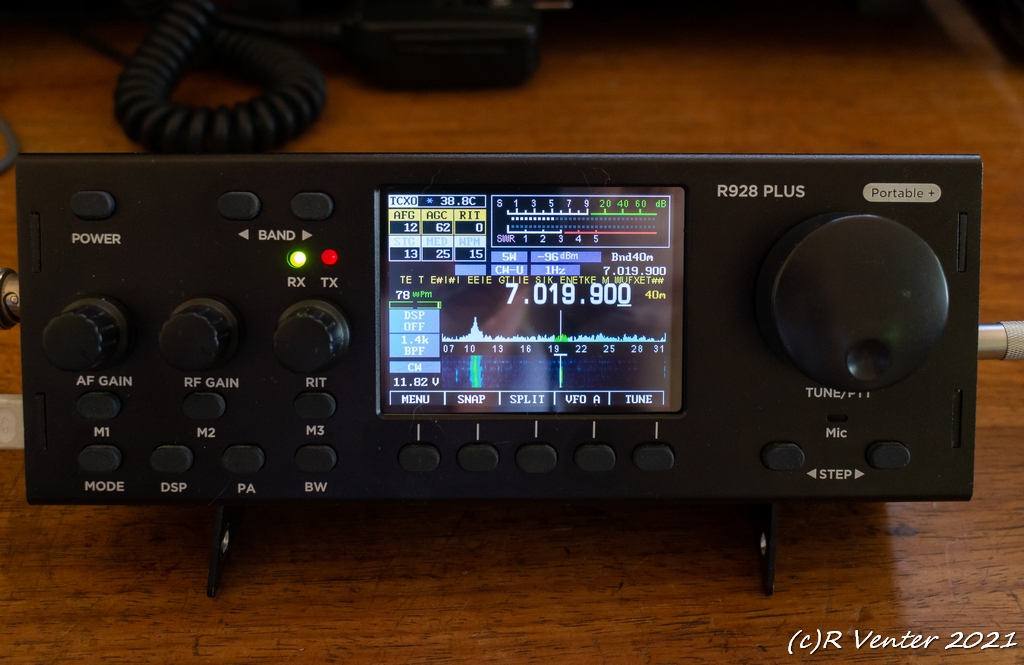
R928 Plus up and
running
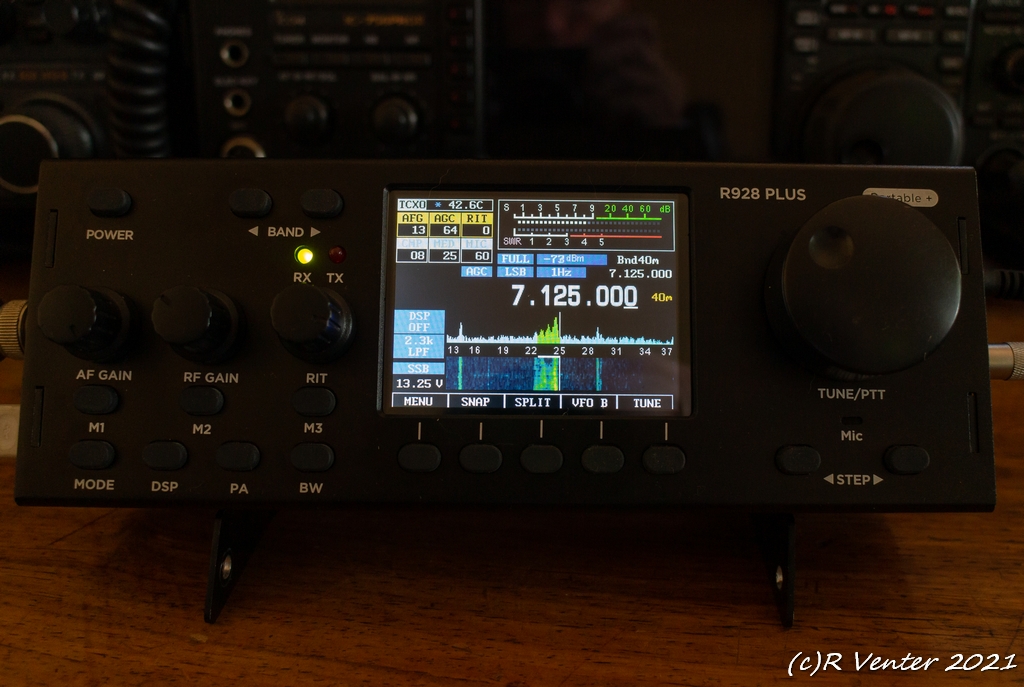
I think I
am going to love this little radio!
Update 1/10/2014:
A quick update on the QRP DXCC quest. As of this afternoon I am standing on 253
worked and 156 confirmed. So far it has been relatively easy but that will soon
be over with all the easy ones worked, now the real challenge starts....
Update
23/8/2014:
I just had DXCC entity (QRP) number 100 confirmed this morning. This was since
May this year when I became active again and started with a QRP only DXCC quest.
I have actually worked around 180 but I have 100 confirmations via LoTW. Number
100 was Reunion on 40m as a matter of interest.
Update
7/7/2014:
A few notes on techniques I use when QRP contesting and DX'ing, also
applicable if you run higher power.
The two things I do when I am
contesting (and DX'ing) seriously with QRP or even high power that helps with
totals are:
1) When conditions are not good enough to run a frequency
with QRP "Search and Pounce" is the only game in town. When I do this there are
a few smaller details that work.
Firstly I do not randomly jump around
the band segment. I will take the segment where the action is from one side and
slowly work up or down. I make a note of VERY station I hear calling CQ. When I
ID a station I will try and work him (the actual technique differs according to
the situation but I will elaborate on this in a later post).
If I cannot
work him within a few calls I will move on, but with his call and freq noted for
the next pass. I use a large piece of paper and mark the frequencies and calls
in sequence on that. If I hear a station I have worked or I am not interested
(in a DX situation) I will also mark him so that I do not waste time on him on
the next pass.
After a few passes it is a good idea to re-listen to all
stations again as it might be a different station on the same freq.
2)
While all the above is happening I use the second RX (in the same radio) to
listen "ahead" on the same band to ID the next station I want to try. This can
be confusing in the beginning but you soon get used to it. It might help to run
the 2 frequencies on a headset, one into each ear.
What I do is while
the main station I am trying to work is busy giving a report to someone else I
will concentrate on the second RX. Sometimes there will be an "easy" one on the
second RX so I will quickly make that the main one and work him. I always try to
be aware of conditions on the second radio, if I hear someone calling without
replies I will pounce on him quickly!
This works well as it helps to
keep the rate up, you don't waste time listening to other peoples reports or
waiting for a call sign of someone I do not want to work or have worked.
It is worth noting that when I get to the edge of the segment I work I don't
reverse direction, I QSY to the opposite end again and start from there. As a
habit I normally work bottom to top. Often the "big" stations will grab a spot
towards the bottom of the CW segment with smaller stations higher up. Sometimes
the smaller stations are easier to work as they do not have huge pile-ups.
3. While all the above is happening I will have a second radio, on a second
antenna (often just a fan-dipole), Listening to a different band. Depending on
the direction the MUF is moving I might be listening above or below the main
band I am working. The main purpose of this radio is to look for band openings.
Often when a band opens you will hear a station calling with a decent signal but
no-one is getting back to him. This is the IDEAL time to snag him with your QRP
signal!
At some point as the MUF and conditions change the second radio
will become more productive than the main. I will then move the main radio, with
the best antenna, to that band and QSY the second radio up or down the spectrum
depending on where the action is.
I also use the second radio to look for
multipliers on other bands that might be open but maybe not as open as the main
band.
All of this can get quite noisy and confusing, I might be listening
on up to 4 frequencies at the same time (the second radio also runs 2 x RX's if
conditions are good or towards the end of the contest when I have worked most
workable stations) but I promise with practice it becomes easier. On CW the
ability to listen to more than one station at a time helps......
Update
1/7/2014: I only had a little bit
of time for amateur radio today but it was fun! After making up a new paddle too
radio cable for the FT-817, it uses a small plug for the key, I decided to try
it on the bands. 20m produced a few JA stations and a bit later a few US
stations, signals were weak but workable. After the band closed I moved to 40m
for a few local contacts. I found 5R8UI calling on 7.153 SSB, a call at 5W
secured the QSO for a new one on QRP, wish it was CW....
After that I worked a few
locals stations on 7.020, the local CW "water hole", it was nice to see so much
local CW activity! After this it was back to 20m where a CQ resulted in a small
pile-up, have not had one of those for years! The 20m band was behaving
strangely, it seemed to close and then a while later there would be strong
signals again only to fade again after a few minutes. A final opening produced
YU1DW (Serbia) before it seemed to close for the evening.
Update
30/6/2014: A nice surprise awaited me when I checked on my QSL
cards on eQSL.net this morning, DXCC entity 100 confirmed, this is for contacts
since I returned to amateur radio on 25 May this year, all contacts were on CW
and running QRP power. Now the challenge is to get to 300+ DXCC entities running
only QRP, that won't be easy!
I need to sort out my LOTW accreditation,
it seems to be taking long.....
Contests
As a keen
contester I have also competed in a few contests using QRP. For these contests I
used the FT-817 from my base station feeding a TH5DX antenna with good results,
including winning a CQWW WPX SSB contest (QRP) and setting an all time record
that still stands for Africa during a CQWW CW contest, see the results below:
ARRL 10m DX
Contest 2002
CQ WW WPX SSB (29-30/03/2003)
CQ WW WPX CW (24-25/05/2003)
ARRL DX CW (15-16/02/2003)
In 2003 I competed in the ARRL DX CW completion using QRP. The score I posted was enough to win the contest (QRP section). Today (2014) the score still stands as a continental record! Below you can see the extract from the ARRL records database:
===================================== C O N T I N E N T A L R E C O R D S ============================== ======= Continent Category Station Score QSOs Mults Year ------------------------------ ------------------------------ ------------ Africa SO MIX QP 5Z4FO 55678 192 97 1992 Africa SO MIX LP CT9/R9DX (R9DX, op.) 2201000 2673 250 2013 Africa SO MIX HP ZD8Z (N6TJ, op.) 4733880 5063 309 2002 Africa SO SSB QP EA8AUW (EC8AUA, op.) 2400 50 24 2005 Africa SO SSB LP EA8MT 610450 2114 145 2011 Africa SO SSB HP D4C (IZ4DPV, op.) 1885290 4810 197 2013 Africa SO CW QP ZS6DX 138376 364 98 2002 Africa SO CW LP CN8KD 841728 1550 137 2013 Africa SO CW HP ZD8LII (G0LII, op.) 1367520 2310 148 1992 Africa MS LP ZR9C 825440 1171 220 2013 Africa MS HP D4C 4351000 3962 380 2011
Update 21/06/2014:
Late afternoon I moved
the IC-728 to the workbench to check out why it is only outputting 50W. Since it
was in use as my "rag chew" radio I decided to put another radio in the same
position till later. I gave my trusty old Yaesu FT-850 (Japanese version of the
FT-890) a clean and a test. Once it was connected I looked around the bands and
found some CW signals on 20m, sounded like a contest with signal reports and
zones.
I connected a key and soon I was having great fun running 5W into
the G5RV. Eventually the band closed down but by then I had more than 100
contacts in the log most from Japan, the far east and eastern Europe. Great fun
and running 5W makes it even better. I am feeling a lot more comfortable running
high speed CW, I am really looking forward to a full CW contest in our spring or
summer with good propagation.
QRP is still great fun and when conditions
are poor like they are at the moment it can be a fun challenge!
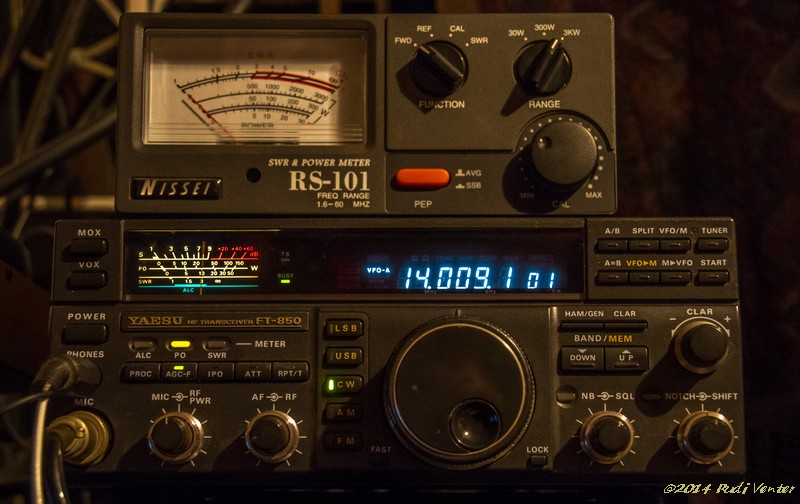
Yaesu FT-850 humming
away on 14MHz CW, I love the great (optional) CW filters on this old radio.
Update 14/06/2014: Today I decided to
practice my CW a bit. Initially I only heard a few weak signals on 15m, slowly
they started picking up till they were workable with low power (I am still
loving QRP, running 4w out of the IC-728 according to my Bird watt meter).
I quickly realized that there was some kind of contest going on! Soon I was
in the swing of things and working stations one after the other, having fun! By
the time the band started going down again I had around 50 stations in the log.
What was may more important was that my CW is really picking up! Both in speed,
accuracy and "filter" capabilities on a crowded band. I was using my old
"rag-chew on 40" IC-728 set to about 4w (lowest setting) that has no CW filters
or DSP, need to move the CW key to a better CW radio.
What I did find
interesting was that even though the bands are not great and signals were low,
most hardly moving the needle, I still managed to work all the stations I
called, and quite a few on the first call. I was using the G5RV antenna at about
20m so the antenna was not the greatest. QRP does work, and when you combine it
with CW you can work the world!
(c)1996-2025 R Venter